Empirical EV Load Model for Distribution Network Analysis
Abstract
1. Introduction
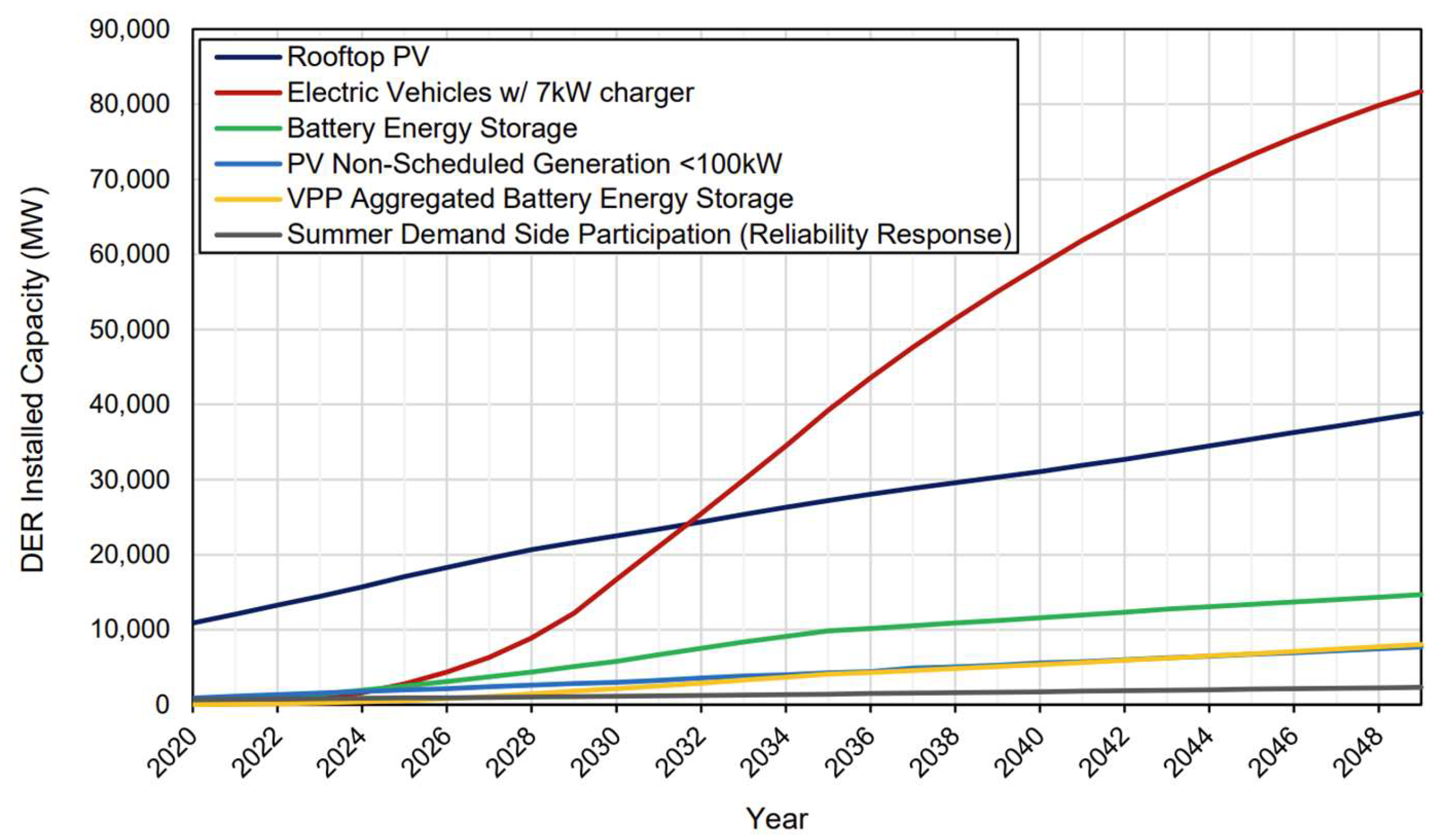
1.1. Impact of EV Charging on Distribution Network
1.2. Impact of Power Quality Disturbances on EV Charging
- Development of an expanded measurement database to enable more accurate static EV load modelling under real-world distribution network conditions.
- Calculation of conservation voltage reduction (CVR) factors for active power, which are critical for accurately assessing EV adoption electricity demand and impact on consumption, including economics aspects thereof.
1.3. Review of Modelling of EV Charging Load
- is the nominal power at nominal voltage ;
- is the voltage exponent ( for CPL, CCL, and CIL—constant impedance load, respectively);
- and are additional scaling coefficients.
- Component-based methods—deriving values from manufacturer specifications and circuit characteristics, or
- Measurement-based methods—extracting parameters through regression analysis of operational charging data.
1.4. Paper Organization and Contribution
- Comprehensive laboratory evaluation of the electrical characteristics of EV charging for a wide range of practical supply voltage magnitudes. Performance has been evaluated for a range of EVs models and several charger types, including Level 1 and Level 2.
- Development of static EV charging load models for both Level 1 and Level 2 chargers based on the experimental data, which accurately captures the relationship between supply voltage magnitude and EV charger electrical performance.
- Evaluation of the potential impacts of increasing penetration of EV charging loads when integrated into a case-study model of a PV-rich Australian distribution network. This modelling case study, implemented using the OpenDSS software package, also allows comparative analysis between the empirically informed EV charging load model and a CP EV load model.
- Section 2 presents the laboratory evaluation of EV charging performance under varying supply voltage magnitude conditions, along with the methodology and development of the empirical EV load model. The experimental procedures, results, and analysis are detailed.
- Section 3 describes the OpenDSS simulation model used for power flow analysis. It includes an assessment of the impact of increasing EV charger load on LV networks. This model also allows comparative evaluation of the empirical EV model and a CP load model and demonstrates the application of the model in an Australian distribution network.
- Section 4 concludes the paper and provides recommendations for future research to be completed over the next 12 months.
2. Experimental Evaluation of EV Charging Characteristics
2.1. Methodology
- Charger A—Level 1 Charger supplied with each vehicle with a rating of 10 A (2.3 kW at 230 V);
- Charger B—Level 2 Charger with a rating of 32 A (7.4 kW at 230 V);
- Charger C—Level 2 Charger with a rating of 32 A (7.4 kW at 230 V).
2.2. Analysis of Experimental Results
2.2.1. Level 1 Chargers
2.2.2. Level 2 Chargers
2.2.3. CVR Factors
2.3. Empirical EV Load Model
3. Impact of EV Load Model on Distribution Network Performance
3.1. Distribution Network Simulation Methodology
3.1.1. Australian Distribution Network Topology
3.1.2. LV Network Modelling
3.2. Analysis of Simulation Results
3.2.1. Impact of EV Load Model on LV Network
- The first scenario assumed that all EVs were charged using Level 1 chargers.
- In the second scenario, a mixed charger load was adopted: 50% of the EVs used Level 1 chargers, while the remaining 50% used Level 2 chargers. This distribution aligns with data reported by Evenergi for Ausgrid (Ausgrid is an Australian DNSP that supplies power to homes and businesses in Sydney, the Central Coast, and the Hunter Valley in New South Wales, serving over 4 million people) [55], which indicates that approximately 55% of EV owners in Australia own Level 2 chargers, while 41% rely on Level 1 charging. For the worst-case assessment, Level 2 chargers were connected to the most remote buses (Buses 9–16) of the network.
3.2.2. Verification of the Empirical EV Load Model in a Typical Australian LV Network
4. Conclusions
Author Contributions
Funding
Data Availability Statement
Conflicts of Interest
Abbreviations
| BESS | Battery energy storage |
| CC-CV | Constant current–constant voltage |
| CCL | Constant current load |
| CIL | Constant impedance load |
| CMC | California Mobility Centre |
| CPL | Constant power load |
| CVR | Conservation voltage reduction |
| DG | Distributed generation |
| DNSP | Distributed network service provider |
| DPF | Displacement power factor |
| DSTATCOM | Distributed static compensator |
| EMC | Electromagnetic compatibility |
| EV | Electric vehicle |
| EVSE | Electric vehicle supply equipment |
| G2V | Grid-to-vehicle |
| LV | Low voltage |
| MV | Medium voltage |
| NERC | North American Electric Reliability Corporation |
| PEV | Plug-in electric vehicle |
| PF | Power factor |
| PQ | Power quality |
| PV | Photovoltaic |
| RDG | Renewable distributed generation |
| RMS | Root-mean-square |
| RoCoF | Rate of change of frequency |
| SOC | State of charge |
| THD | Total harmonic distortion |
| V2G | Vehicle-to-grid |
| WECC | Western Electricity Coordinating Council |
References
- International Energy Agency, Paris. Global EV Outlook 2024. Available online: https://www.iea.org/reports/global-ev-outlook-2024 (accessed on 24 February 2025).
- Australian Energy Market Operator (AEMO). Fact Sheet: The National Energy Market. Available online: https://www.aemo.com.au/-/media/files/electricity/nem/national-electricity-market-fact-sheet.pdf (accessed on 12 April 2025).
- Elphick, S.; Robinson, D.A.; Perera, S.; Knott, J.C.; David, J.; Drury, G. Impact of Sustained Supply Voltage Magnitude on Consumer Appliance Behaviour. IEEE Trans. Power Deliv. 2022, 37, 4933–4944. [Google Scholar] [CrossRef]
- Department of Climate Change, Energy, the Environment and Water. Australian Energy Update 2024. Available online: https://www.energy.gov.au/sites/default/files/2024-08/australian_energy_update_2024.pdf (accessed on 22 February 2025).
- David, J.; Ciufo, P.; Elphick, S.; Robinson, D. Preliminary Evaluation of the Impact of Sustained Overvoltage on Low Voltage Electronics-Based Equipment. Energies 2022, 15, 1536. [Google Scholar] [CrossRef]
- Ochoa, L.N.; Givisiez, A.G.; Jaglal, D.; Liu, M.Z.; Nacmanson, W. CSIRO Australian Research Planning for Global Power Systems Transformation, Topic 8 “Distributed Energy Resources”; The University of Melbourne: Melbourne, Australia, 2021; Available online: https://www.csiro.au/-/media/EF/Files/GPST-Roadmap/Topic-8-DERs-Final-Report.pdf (accessed on 6 December 2024).
- AS 60038:2022; Standard Voltages. Standards Australia: Sydney, Australia, 2022.
- Graham, P. Electric Vehicle Projections 2022; CSIRO: Canberra, Australia, 2022.
- Deb, S.; Kalita, K.; Mahanta, P. Review of impact of electric vehicle charging station on the power grid. In Proceedings of the 2017 International Conference on Technological Advancements in Power and Energy (TAP Energy), Kollam, India, 21–23 December 2017; pp. 1–6. [Google Scholar] [CrossRef]
- Ochoa, L.N.; Miller, M.; Quirós-Tortós, J. New demand, new challenges, and new opportunities: Making EVs and the grid work together [Guest Editorial]. IEEE Power Energy Mag. 2023, 21, 15–17. [Google Scholar] [CrossRef]
- Dubey, A.; Santoso, S. Electric Vehicle Charging on Residential Distribution Systems: Impacts and Mitigations. IEEE Access 2015, 3, 1871–1893. [Google Scholar] [CrossRef]
- Amiri, M.M.; Aghajan-Eshkevari, S.; Rahimi, M.A.; Samari, A. A Review on Utilization of Electric Vehicles for Mitigating the Power Quality Issues in Power Systems. In Power Quality—New Insights; Azizan, M.M., Ed.; IntechOpen: Rijeka, Yugoslavia, 2024. [Google Scholar]
- Chen, F.; Zhong, Q.; Zhang, H.; Zhu, M.; Müller, S.; Meyer, J.; Huang, W. Survey of Harmonic and Supraharmonic Emission of Fast Charging Stations for Electric Vehicles in China and Germany. In Proceedings of the CIRED 2021—The 26th International Conference and Exhibition on Electricity Distribution, Online, 20–23 September 2021; pp. 1061–1065. [Google Scholar] [CrossRef]
- Ahmadi, A.; Tavakoli, A.; Jamborsalamati, P.; Rezaei, N.; Miveh, M.R.; Gandoman, F.H.; Heidari, A.; Nezhad, A.E. Power quality improvement in smart grids using electric vehicles: A review. IET Electr. Syst. Transp. 2019, 9, 53–64. [Google Scholar] [CrossRef]
- Babaeiyazdi, I.; Rezaei-Zare, A.; Shokrzadeh, S. DFACTS-Based Mitigation of Power System Voltage Unbalance for Wide Adoption of EV Fast Charging Systems. In Proceedings of the 2021 IEEE Electrical Power and Energy Conference (EPEC), Toronto, ON, Canada, 22–31 October 2021; pp. 1–6. [Google Scholar] [CrossRef]
- Acharige, S.S.G.; Haque, E.; Arif, M.T.; Hosseinzadeh, N.; Hasan, K.N.; Oo, A.M.T. Review of Electric Vehicle Charging Technologies, Standards, Architectures, and Converter Configurations. IEEE Access 2023, 11, 41218–41255. [Google Scholar] [CrossRef]
- Zhu, X.; Mather, B.; Mishra, P. Grid Impact Analysis of Heavy-Duty Electric Vehicle Charging Stations. In Proceedings of the 2020 IEEE Power & Energy Society Innovative Smart Grid Technologies Conference (ISGT), Washington, DC, USA, 17–20 February 2020; pp. 1–5. [Google Scholar] [CrossRef]
- Zhu, X.; Mishra, P.; Mather, B.; Zhang, M.; Meintz, A. Grid Impact Analysis and Mitigation of En-Route Charging Stations for Heavy-Duty Electric Vehicles. IEEE Open Access J. Power Energy 2023, 10, 141–150. [Google Scholar] [CrossRef]
- Bhattacharjee, T.; Rajeshwari, M.; Kumar, K.J. Electric Vehicle Charging and its Effects on the Power Distribution Network—A Review. Power Res. 2024, 20, 89–98. [Google Scholar] [CrossRef]
- Yuvaraj, T.; Devabalaji, K.R.; Kumar, J.A.; Thanikanti, S.B.; Nwulu, N.I. A Comprehensive Review and Analysis of the Allocation of Electric Vehicle Charging Stations in Distribution Networks. IEEE Access 2024, 12, 5404–5461. [Google Scholar] [CrossRef]
- Quiros-Tortos, J.; Ochoa, L.; Butler, T. How Electric Vehicles and the Grid Work Together: Lessons Learned from One of the Largest Electric Vehicle Trials in the World. IEEE Power Energy Mag. 2018, 16, 64–76. [Google Scholar] [CrossRef]
- HYibo, H.; DongHong, R.; Tao, Q.; HongWei, C. Impact of high permeability EV charging load on distribution network and its layout planning method. In Proceedings of the 16th IET International Conference on AC and DC Power Transmission (ACDC 2020), Online, 2–3 July 2020; pp. 2293–2299. [Google Scholar] [CrossRef]
- Suski, A.; Remy, T.; Chattopadhyay, D.; Song, C.S.; Jaques, I.; Keskes, T.; Li, Y. Analyzing Electric Vehicle Load Impact on Power Systems: Modeling Analysis and a Case Study for Maldives. IEEE Access 2021, 9, 125640–125657. [Google Scholar] [CrossRef]
- Wu, Y.; Aziz, S.M.; Haque, M.H.; Kauschke, T. Impact of Electric Vehicle Charging Demand on a Distribution Network in South Australia. In Proceedings of the 2023 IEEE International Conference on Energy Technologies for Future Grids (ETFG), Wollongong, Australia, 3–6 December 2023; pp. 1–6. [Google Scholar] [CrossRef]
- Yu, Y.; Shekhar, A.; Mouli, G.C.R.; Bauer, P.; Refa, N.; Bernards, R. Impact of Uncontrolled Charging with Mass Deployment of Electric Vehicles on Low Voltage Distribution Networks. In Proceedings of the 2020 IEEE Transportation Electrification Conference & Expo (ITEC), Chicago, IL, USA, 23–26 June 2020; pp. 766–772. [Google Scholar] [CrossRef]
- Abid, S.; Apon, H.J.; Morshed, K.A.; Abid, F. Impact Assessment of Charging of Electric Vehicle on Residential Distribution Network of Bangladesh. In Proceedings of the 2021 56th International Universities Power Engineering Conference (UPEC), Middlesbrough, UK, 31 August–3 September 2021; pp. 1–6. [Google Scholar] [CrossRef]
- Roy, P.; Ilka, R.; He, J.; Liao, Y.; Cramer, A.M.; Mccann, J.; Delay, S.; Coley, S.; Geraghty, M.; Dahal, S. Impact of Electric Vehicle Charging on Power Distribution Systems: A Case Study of the Grid in Western Kentucky. IEEE Access 2023, 11, 49002–49023. [Google Scholar] [CrossRef]
- Qin, Z.; Wang, L.; Bauer, P. Review on Power Quality Issues in EV Charging. In Proceedings of the 2022 IEEE 20th International Power Electronics and Motion Control Conference (PEMC), Brasov, Romania, 25–28 September 2022; pp. 360–366. [Google Scholar] [CrossRef]
- Manmadharao, S.; Satputaley, R.J.; Keshri, R.K.; Raghava, B.V.S. Effects of Voltage Sag on Grid fed Electric Vehicle Charging Station. In Proceedings of the 2021 IEEE 12th Energy Conversion Congress & Exposition—Asia (ECCE-Asia), Singapore, 24–27 May 2021; pp. 1755–1760. [Google Scholar] [CrossRef]
- Rao, S.M.; Satputaley, R.J.; Keshri, R.K.; Patne, N.R.; Buja, G. Voltage Sag Mitigation using DVR in Grid fed EV Fast Charging Station. In Proceedings of the 2021 AEIT International Conference on Electrical and Electronic Technologies for Automotive (AEIT AUTOMOTIVE), Torino, Italy, 17–19 November 2021; pp. 1–6. [Google Scholar] [CrossRef]
- Ziyat, I.; Gola, A.; Palmer, P.R.; Makonin, S.; Popowich, F. EV Charging Profiles and Waveforms Dataset (EV-CPW) and Associated Power Quality Analysis. IEEE Access 2023, 11, 138445–138456. [Google Scholar] [CrossRef]
- NERC; CMC; WECCE. Electric Vehicle Dynamic Charging Performance Characteristics During Bulk Power System Disturbances; NERC: Abuja, Nigeria; CMC: Abuja, Nigeria; WECCE: Abuja, Nigeria, 2023; Available online: https://www.nerc.com/comm/RSTC/Documents/Grid_Friendly_EV_Charging_Recommendations.pdf (accessed on 17 November 2024).
- Phan, Q.B.; Elphick, S.; Rahman, O. Experimental Evaluation of Impact of Sustained Supply Voltage on Electric Vehicle Charging. In Proceedings of the 2024 21st International Conference on Harmonics and Quality of Power (ICHQP), Chengdu, China, 15–18 October 2024; pp. 777–782. [Google Scholar] [CrossRef]
- Ghosh, A.; Poddar, D.; Singh, R.R. Impact Analysis of Onboard EV Charger under Power Quality Perturbations. In Proceedings of the 2023 9th International Conference on Electrical Energy Systems (ICEES), Chennai, India, 23–25 March 2023; pp. 69–74. [Google Scholar] [CrossRef]
- Haque, M.; Jones, L.; Sturmberg, B.C.P. Response of a Bidirectional EV Charger to Selected Grid Disturbances. In Proceedings of the 2021 IEEE Industrial Electronics and Applications Conference (IEACon), Penang, Malaysia, 22–23 November 2021; pp. 157–162. [Google Scholar] [CrossRef]
- Bertin, L.; Lorenzo, K.; Boukir, K. Smart charging effects on Electric Vehicle charging behavior in terms of Power Quality. In Proceedings of the 2021 IEEE Madrid PowerTech, Madrid, Spain, 28 June–2 July 2021; pp. 1–5. [Google Scholar] [CrossRef]
- Slangen, T.M.H.; Cuk, V.; Cobben, J.F.G.; de Jong, E.C.W. Harmonic Emission of EV Fast Charging Station under Different Supply- and Operating Conditions. In Proceedings of the 2022 IEEE PES Innovative Smart Grid Technologies Conference Europe (ISGT-Europe), Novi Sad, Serbia, 10–12 October 2022; pp. 1–5. [Google Scholar] [CrossRef]
- Slangen, T.; Ćuk, V.; Cobben, J.; De Jong, E. Variations in Supraharmonic Emission (2–150 kHz) of an EV Fast Charging Station under Different Supply- and Operating Conditions. In Proceedings of the 2023 IEEE Power & Energy Society General Meeting (PESGM), Orlando, FL, USA, 16–20 July 2023; pp. 1–5. [Google Scholar] [CrossRef]
- Da Paixão, J.L.; Danielsson, G.; Da Silva, L.; Abaide, A.D.R.; Parqui, W.O.R.; Barriquello, C.H. Analysis of the Power Quality of an EV Fast Charging Station. In Proceedings of the 2024 IEEE URUCON, Montevideo, Uruguay, 18–20 November 2024; pp. 1–5. [Google Scholar] [CrossRef]
- Watson, N.; Watson, R.; Paterson, T.; Russell, G.; Ellerington, M.; Langella, R. Power Quality of a bidirectional Electric Vehicle charger. In Proceedings of the 2020 19th International Conference on Harmonics and Quality of Power (ICHQP), Dubai, United Arab Emirates, 6–7 July 2020; pp. 1–5. [Google Scholar] [CrossRef]
- J1772_202401; SAE Electric Vehicle and Plug-In Hybrid Electric Vehicle Conductive Charge Coupler. Society of Automotive Engineers: Warrendale, PA, USA, 2024.
- Wang, L.; Lei, X.; Sun, J.; Zha, X. The influence of the EV charging station’s large-scale access to the backbone network. In Proceedings of the 2014 China International Conference on Electricity Distribution (CICED), Shenzhen, China, 23–26 September 2014; pp. 354–359. [Google Scholar] [CrossRef]
- Jain, P.; Jain, T. Assessment of electric vehicle charging load and its impact on electricity market price. In Proceedings of the 2014 International Conference on Connected Vehicles and Expo (ICCVE), Vienna, Austria, 3–7 November 2014; pp. 74–79. [Google Scholar] [CrossRef]
- Shukla, A.; Verma, K.; Kumar, R. Multi-stage voltage dependent load modelling of fast charging electric vehicle. In Proceedings of the 2017 6th International Conference on Computer Applications in Electrical Engineering-Recent Advances (CERA), Roorkee, India, 5–7 October 2017; pp. 86–91. [Google Scholar] [CrossRef]
- Visakh, A.; Selvan, M.P. Voltage Dependent Load Models for EV Chargers to Improve the Accuracy of Grid-Impact Studies. In Proceedings of the 2022 International Virtual Conference on Power Engineering Computing and Control: Developments in Electric Vehicles and Energy Sector for Sustainable Future (PECCON), Chennai, India, 5–6 May 2022; pp. 1–6. [Google Scholar] [CrossRef]
- Sortomme, E.; Negash, A.I.; Venkata, S.S.; Kirschen, D.S. Voltage dependent load models of charging electric vehicles. In Proceedings of the 2013 IEEE Power & Energy Society General Meeting, Vancouver, BC, Canada, 21–25 July 2013; pp. 1–5. [Google Scholar] [CrossRef]
- Haidar, A.M.A.; Muttaqi, K.M. Behavioral Characterization of Electric Vehicle Charging Loads in a Distribution Power Grid Through Modeling of Battery Chargers. IEEE Trans. Ind. Appl. 2016, 52, 483–492. [Google Scholar] [CrossRef]
- Monigaa, N.; Devi, R.P.K. Static Load Modelling of Electric Vehicle Fast Charger For System Studies. In Proceedings of the 2024 Second International Conference on Smart Technologies for Power and Renewable Energy (SPECon), Ernakulam, India, 2–4 April 2024; pp. 1–5. [Google Scholar] [CrossRef]
- Haidar, A.M.A.; Muttaqi, K.M. Impact assessment of electric vehicle demand through load modeling. In Proceedings of the 2013 Australasian Universities Power Engineering Conference (AUPEC), Hobart, TAS, Australia, 29 September–3 October 2013; pp. 1–6. [Google Scholar] [CrossRef]
- Kongjeen, Y.; Bhumkittipich, K. Modeling of electric vehicle loads for power flow analysis based on PSAT. In Proceedings of the 2016 13th International Conference on Electrical Engineering/Electronics, Computer, Telecommunications and Information Technology (ECTI-CON), Chiang Mai, Thailand, 28 June–1 July 2016; pp. 1–6. [Google Scholar] [CrossRef]
- Zafar, H.; Djokic, S.Z.; Langella, R. Voltage-Dependent EV Battery Charger Models for Power Flow and Harmonic Emission Studies. In Proceedings of the 2024 21st International Conference on Harmonics and Quality of Power (ICHQP), Chengdu, China, 15–18 October 2024; pp. 875–880. [Google Scholar] [CrossRef]
- Jha, B.K.; Kumar, A.; Dheer, D.K.; Singh, D.; Misra, R.K. A modified current injection load flow method under different load model of EV for distribution system. Int. Trans. Electr. Energy Syst. 2020, 30, e12284. [Google Scholar] [CrossRef]
- AS/NZS 3000:2018; Electrical Installations. Standards Australia: Sydney, Australia, 2018.
- Misoyannis, A. Australia’s Best-Selling Electric Cars in 2024: Every Model Listed. 2025. Available online: https://www.drive.com.au/news/australias-best-selling-electric-cars-2024/ (accessed on 21 May 2025).
- Evenergi. EV Owner Demographics and Behaviours, Results of EVenergi’s Relevant Surveys. 2023. Available online: https://www.aer.gov.au/system/files/2023-12/Ausgrid%20-%20Revised%20proposal%20-%20EVenergi%20-%20Att.%205.7.5%20-%20EV%20owner%20demographics%20and%20behaviours%20-%2030%20Nov%202023%20-%20Public_0.pdf (accessed on 18 March 2025).
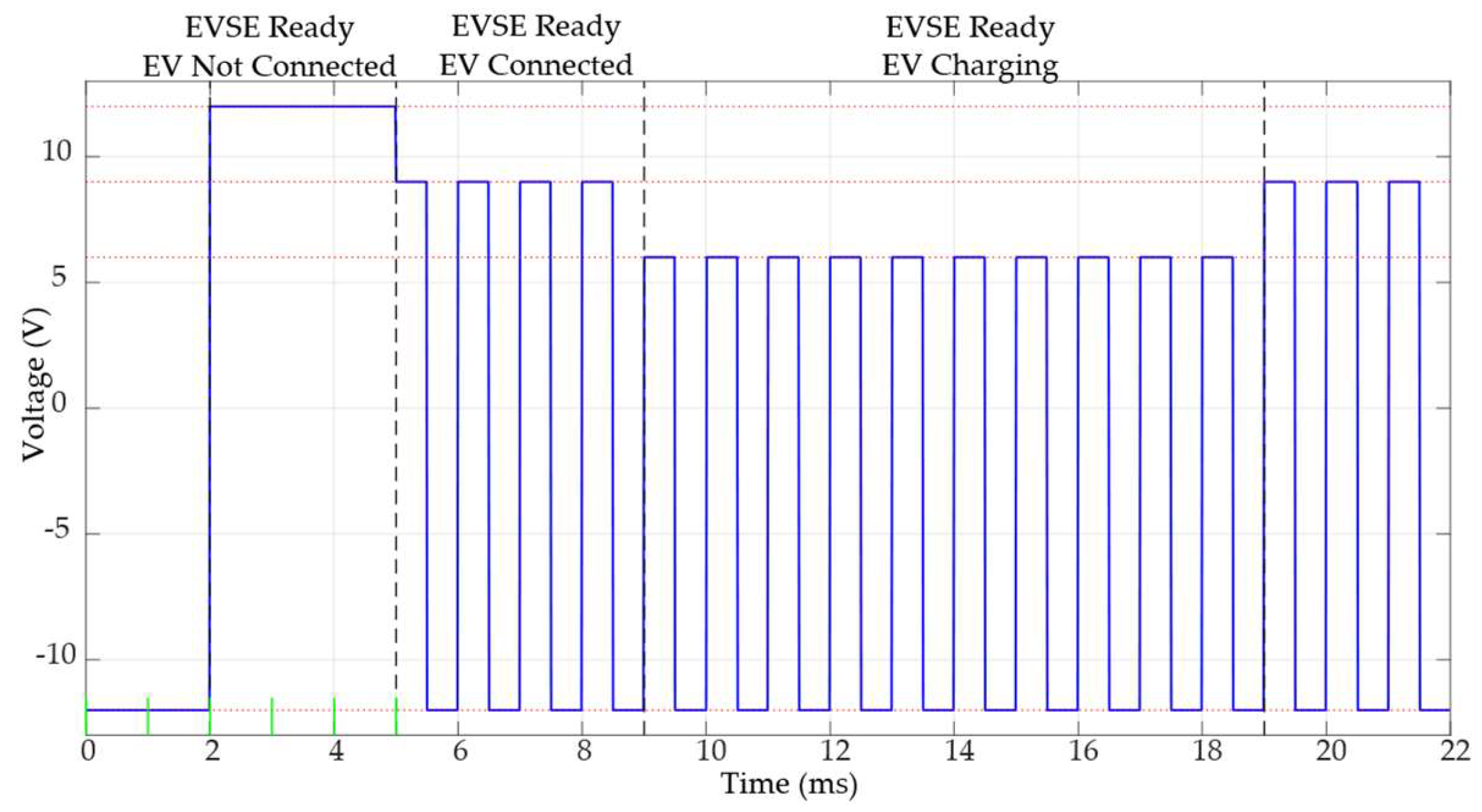
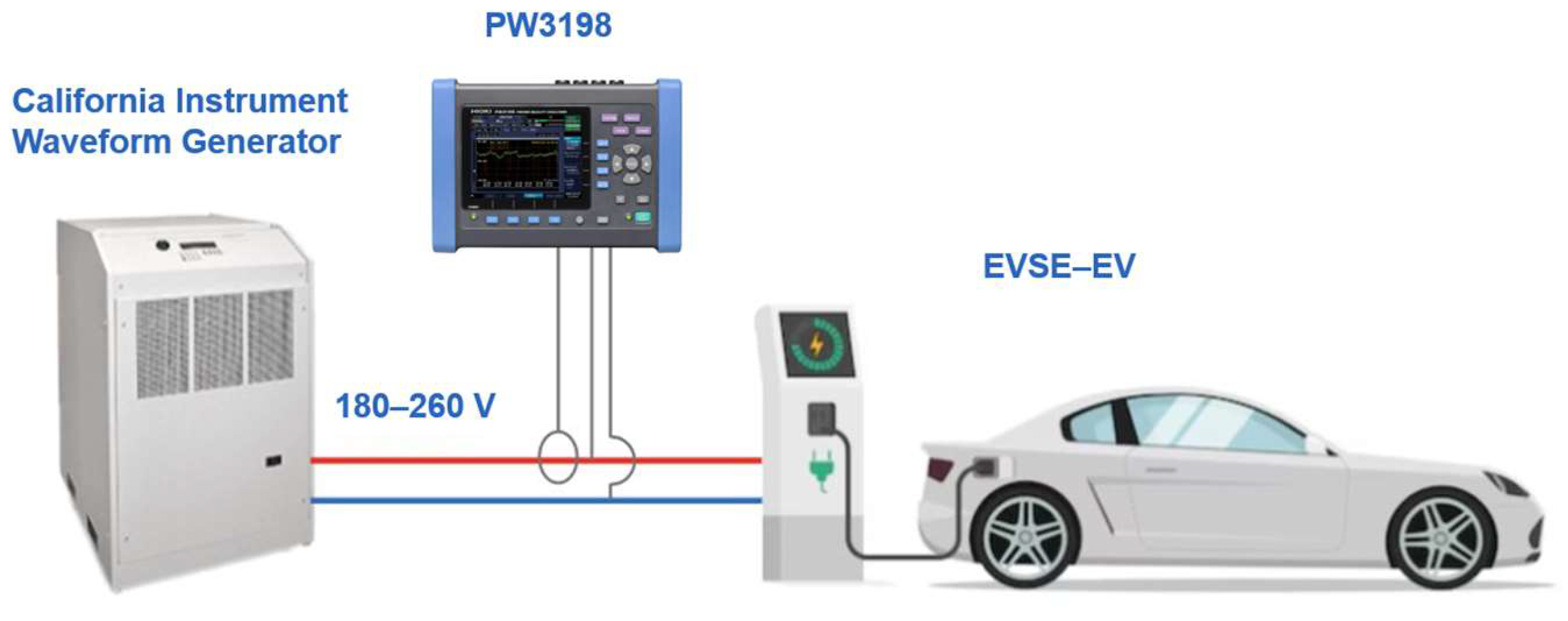
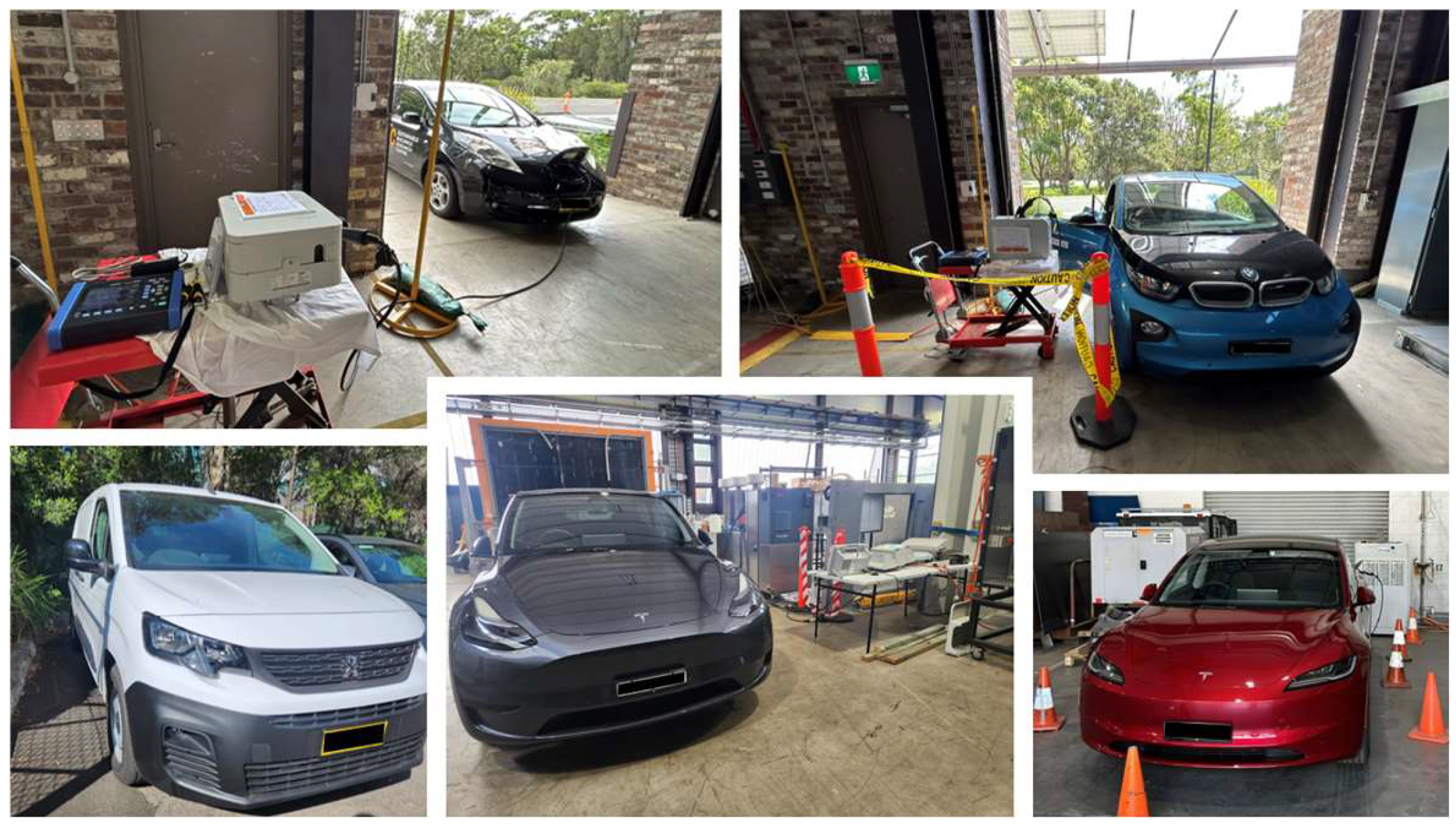
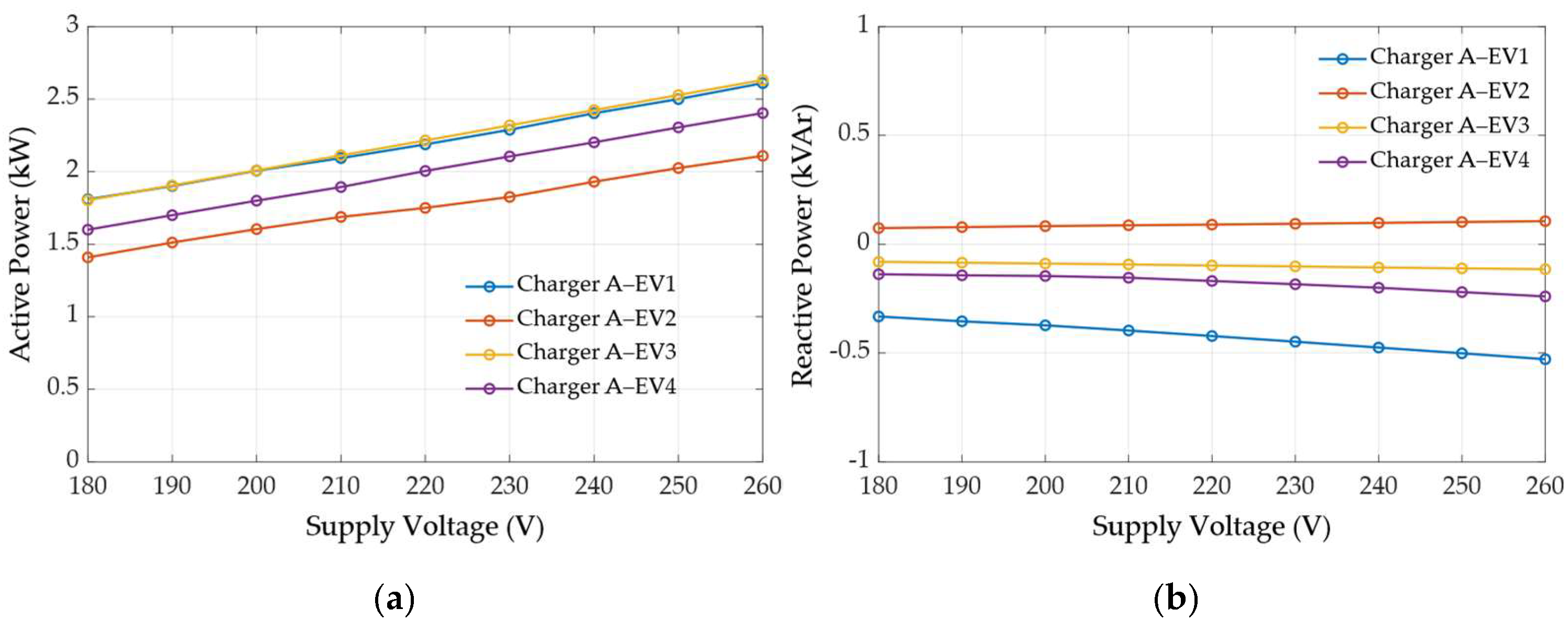
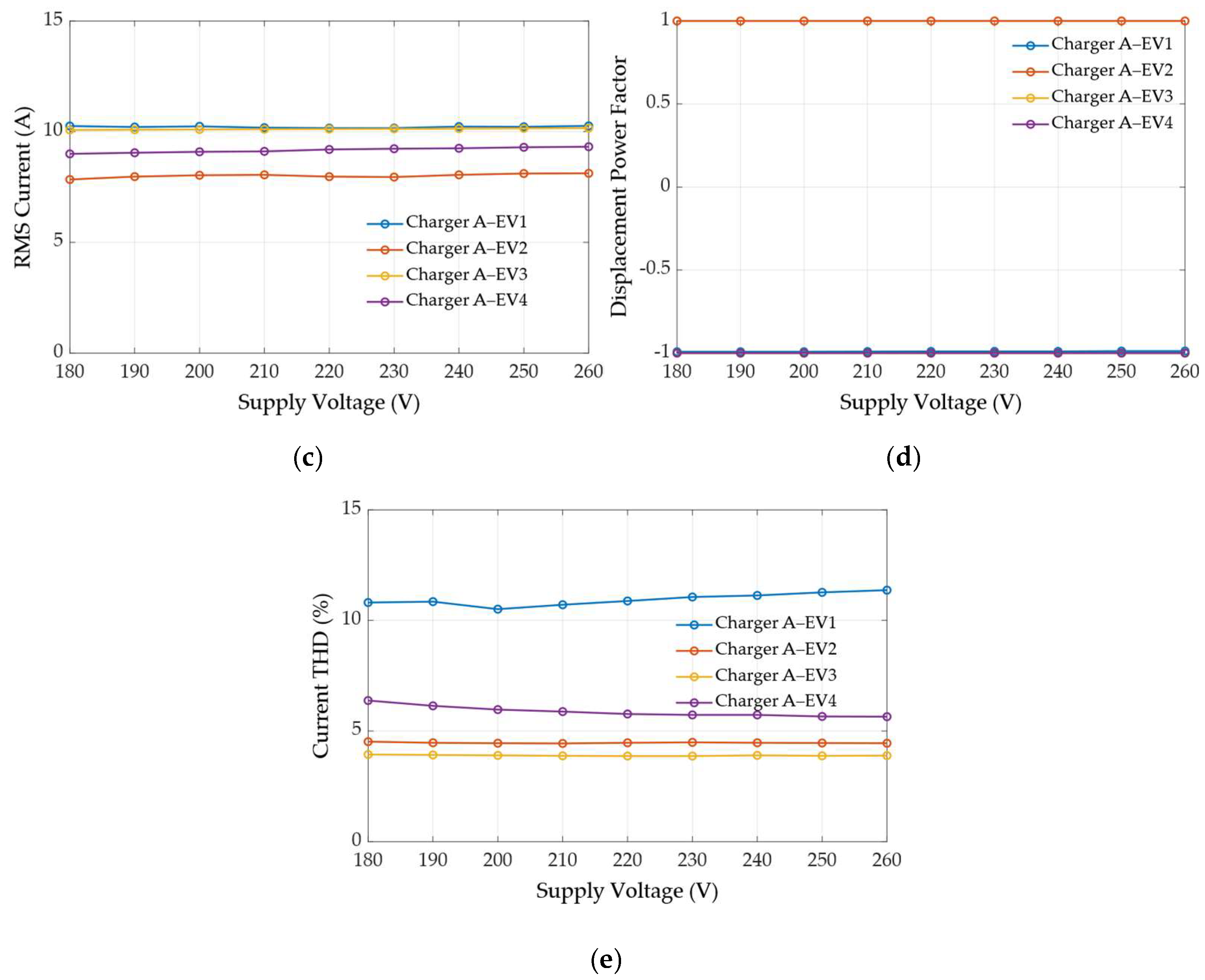


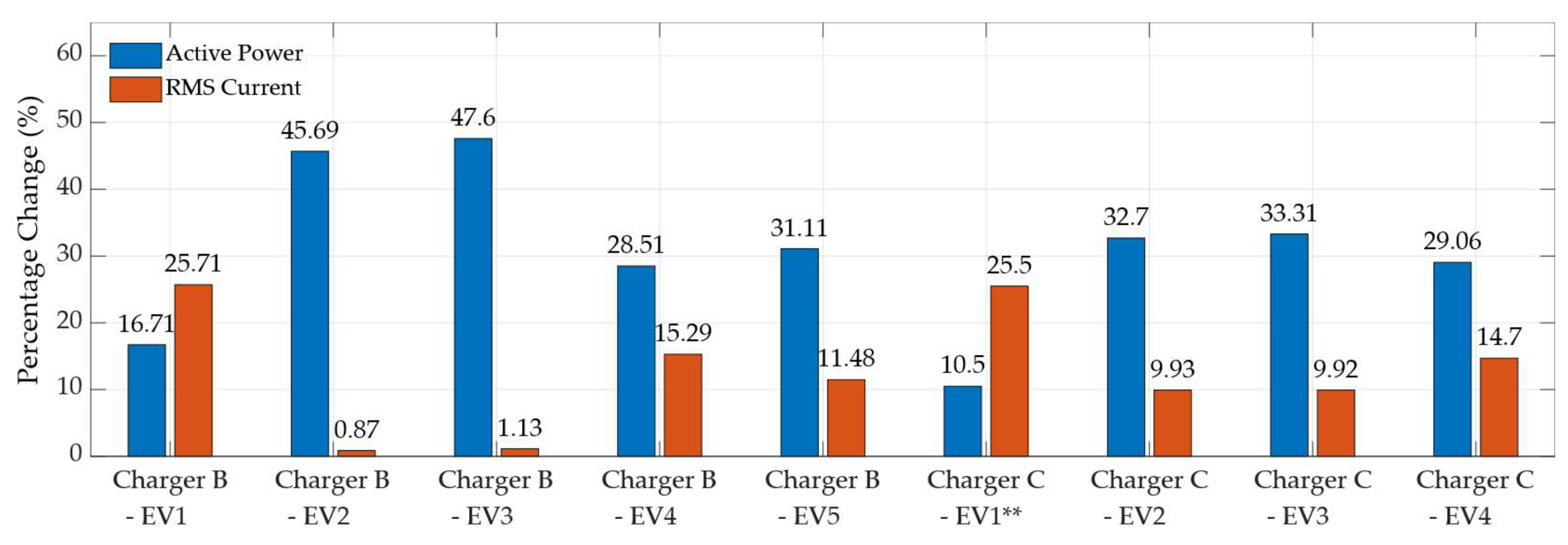
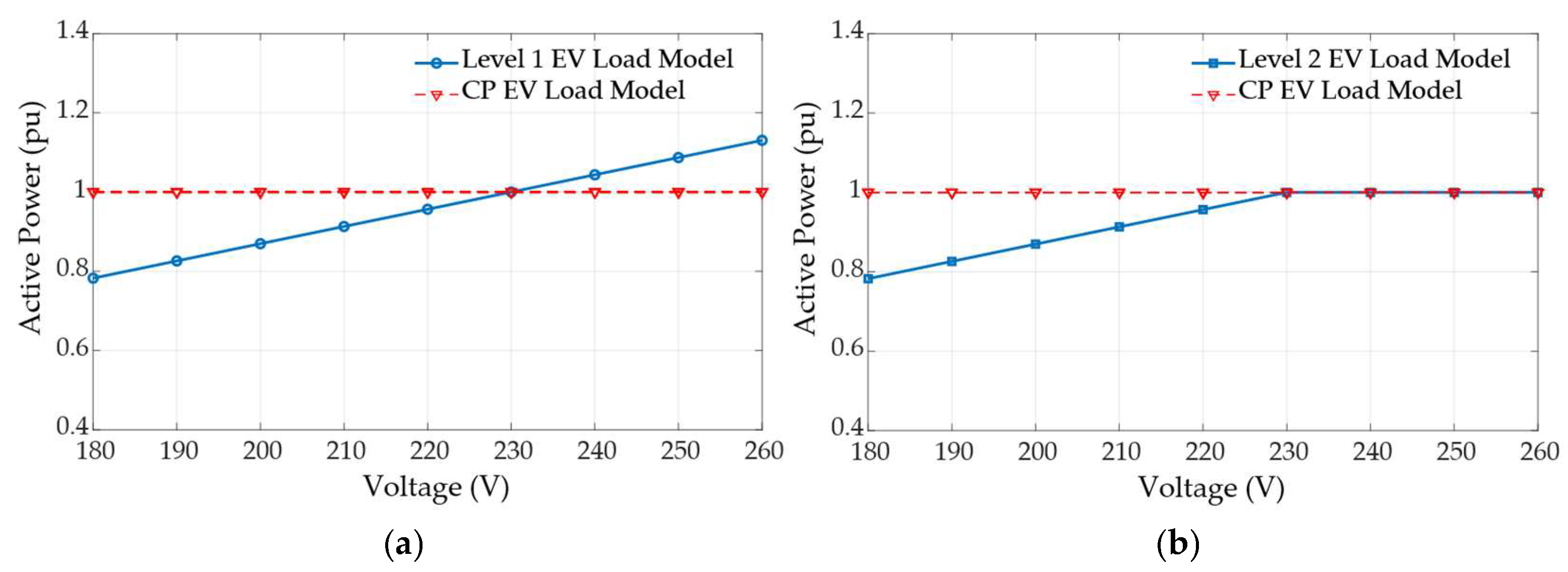
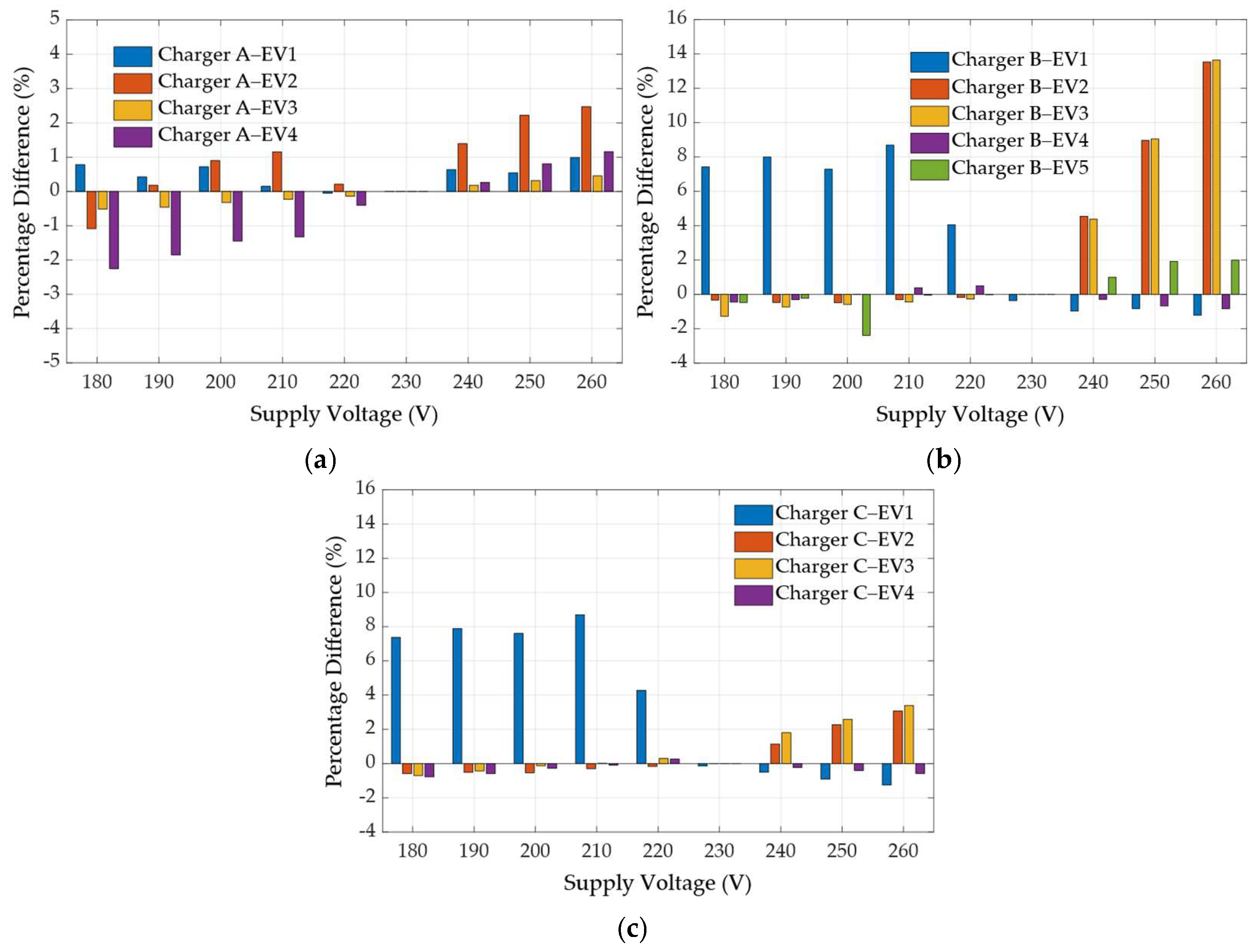


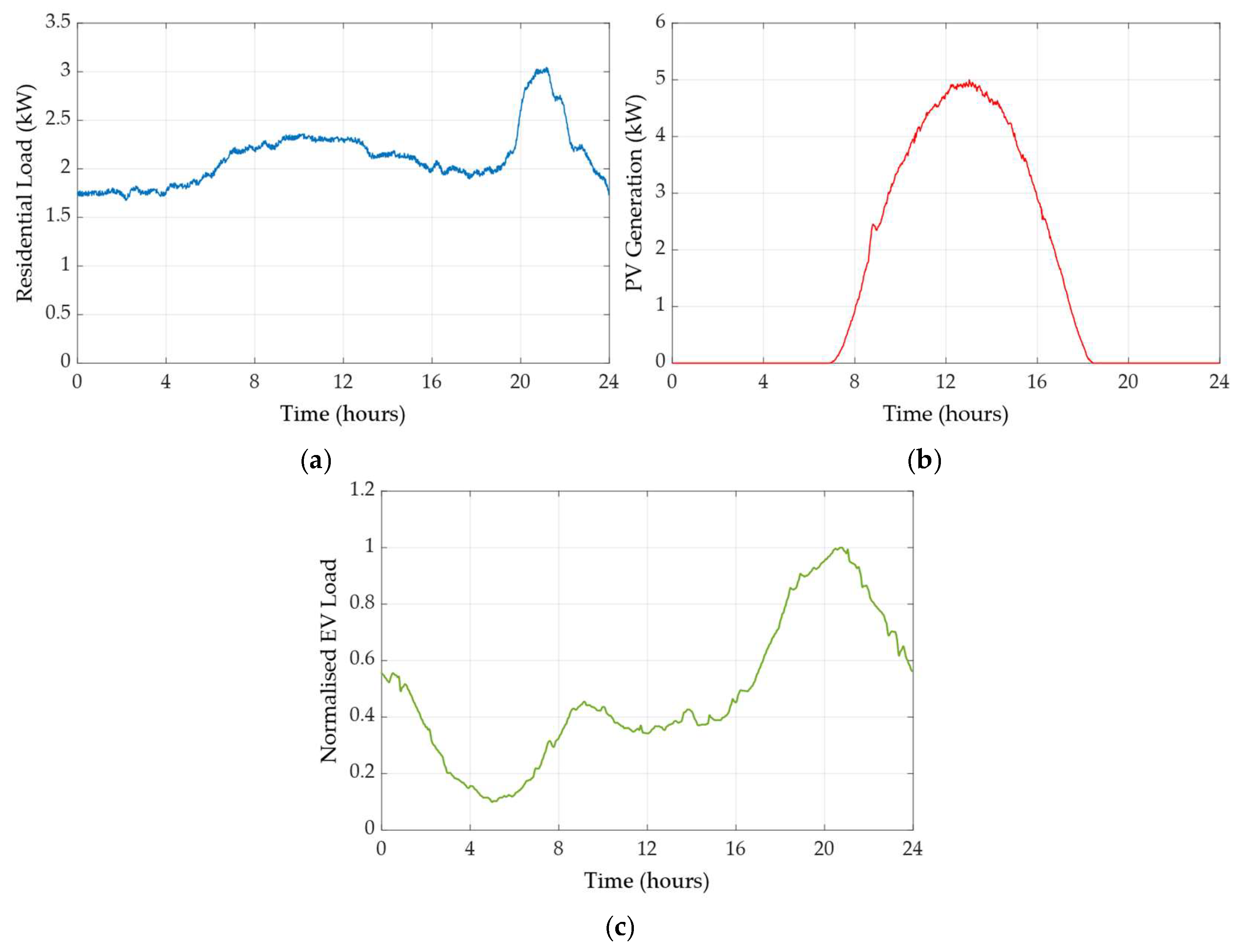
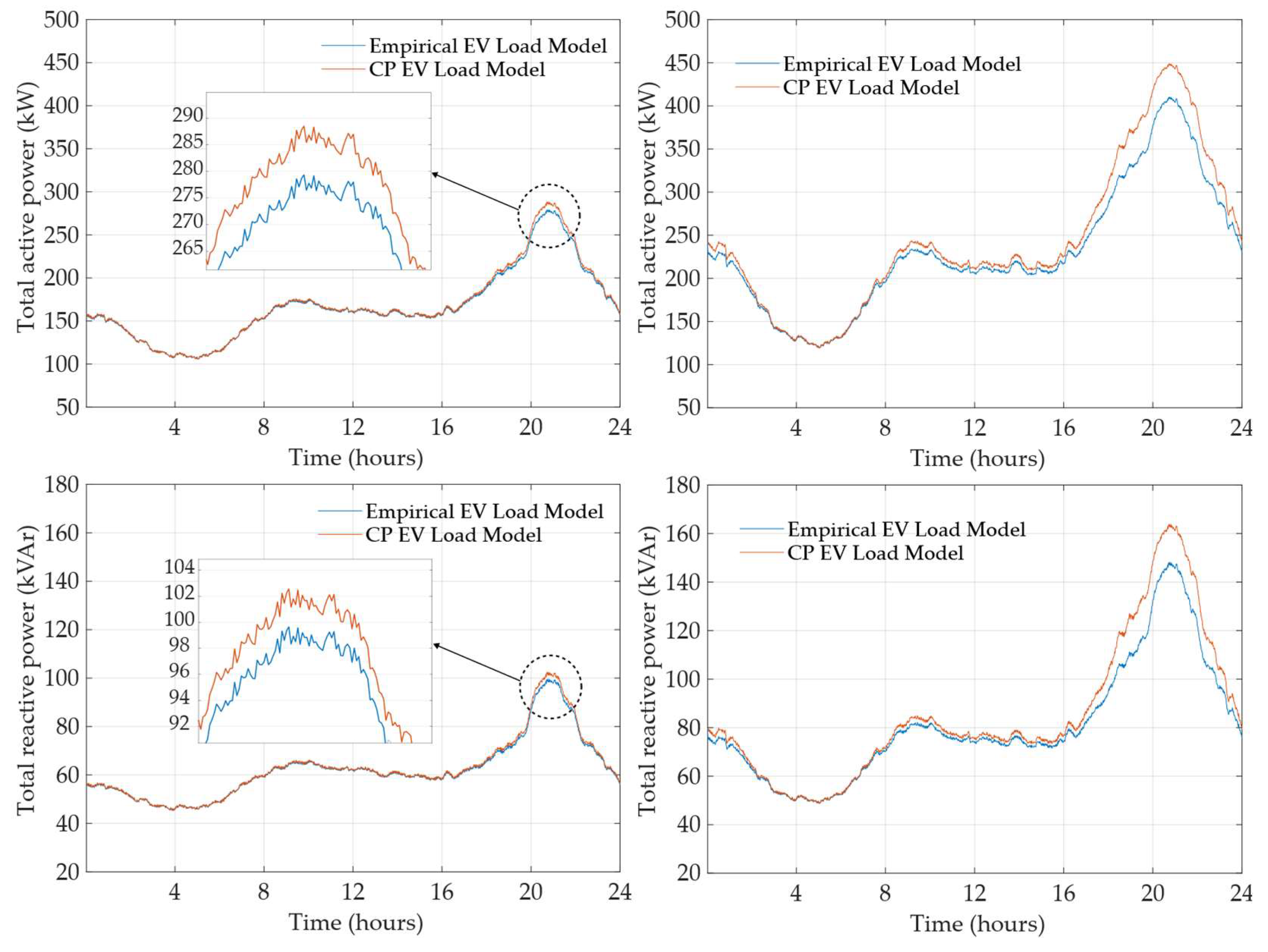
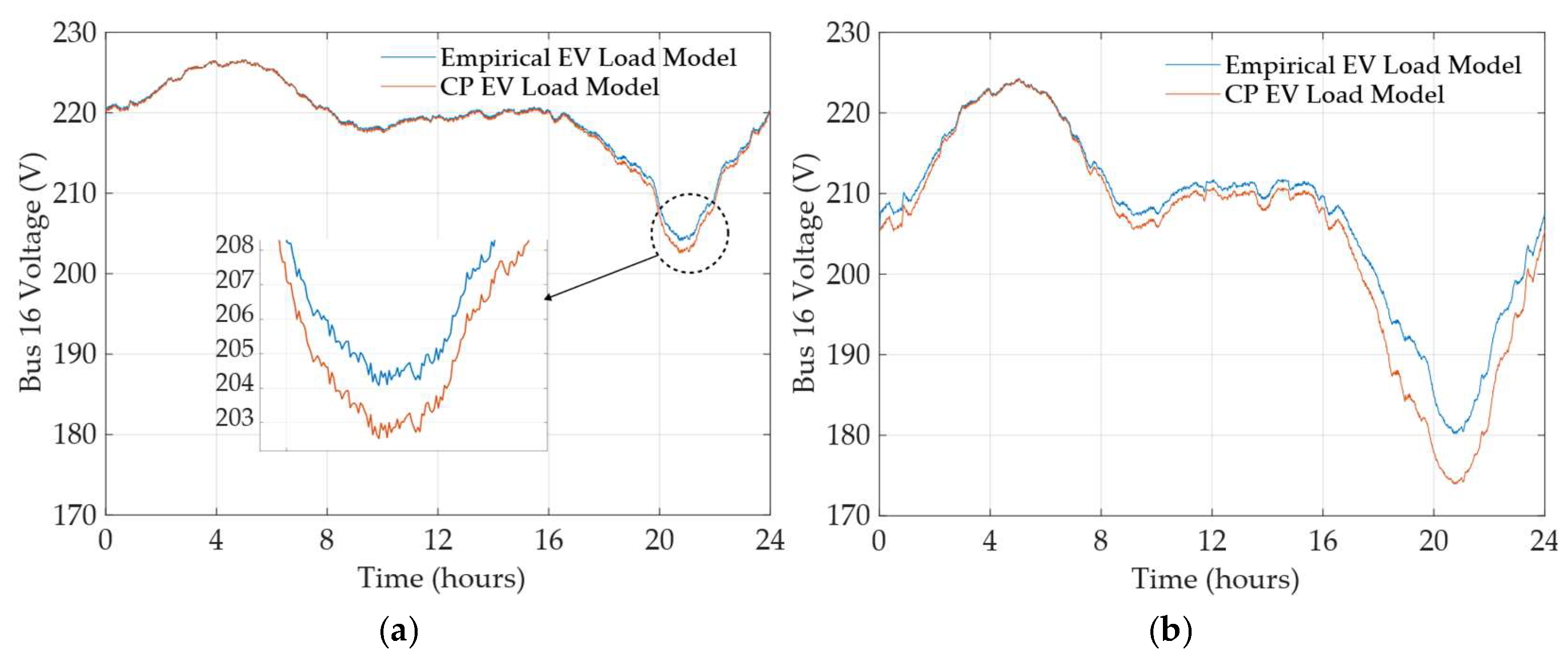


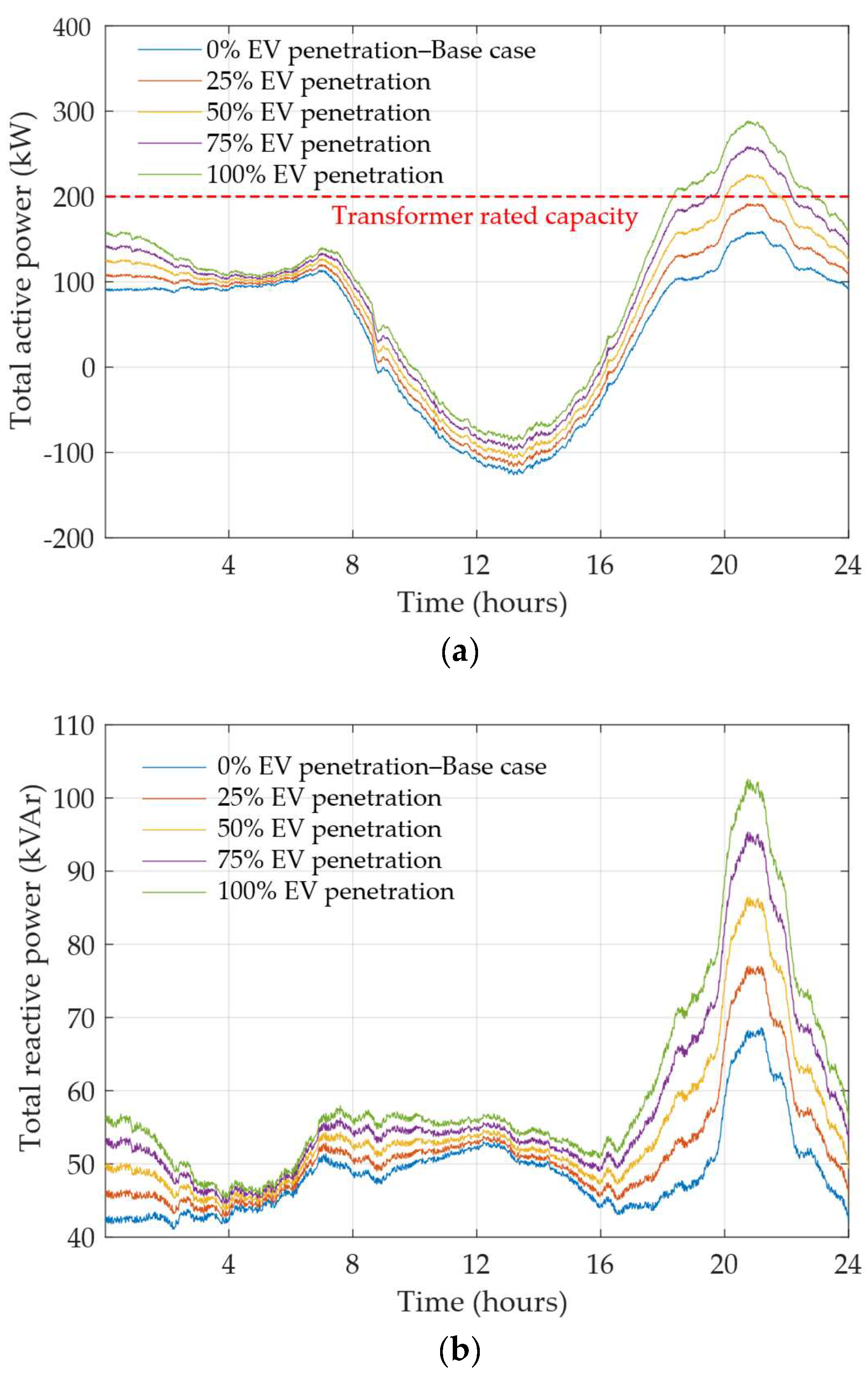
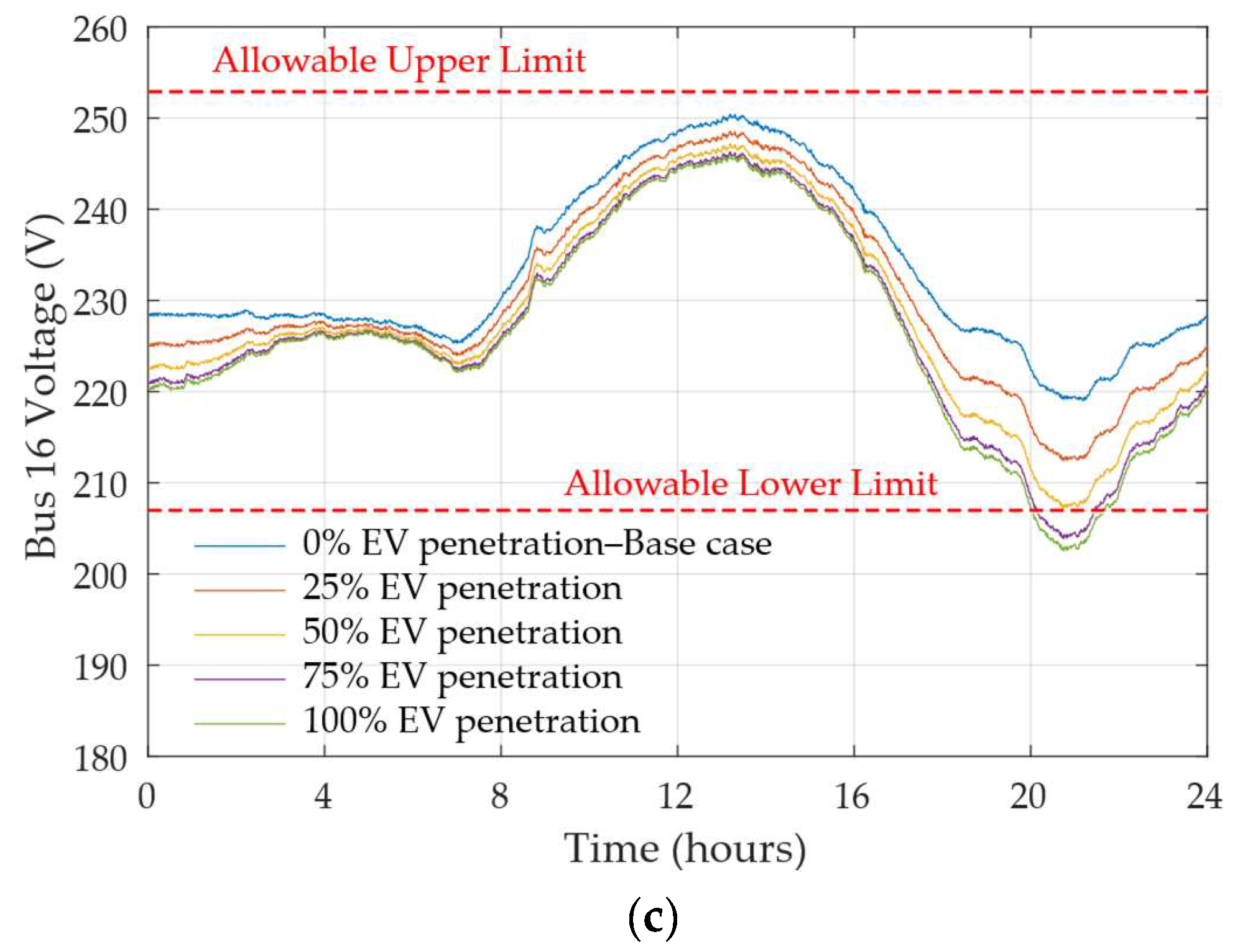
| Level 1 | Level 2 | Level 3 | |
|---|---|---|---|
| Output Power | 1.4–3.7 kW | 7–22 kW | 25–350 kW |
| Mounting Type | On-board | On-board | Off-board |
| Supply Voltage | 120/230 VAC Single-phase | 208/240 VAC Single-phase | 208/240 VAC Three-phase and 300–800 VDC |
| Test Combination | CVRP |
|---|---|
| Level 1 Chargers | |
| 0.99 1.12 1.03 1.12 |
| Level 2 Chargers | |
| 0.37 1.03 1.05 0.63 0.68 0.28 0.73 0.73 0.64 |
| Components | Parameters |
|---|---|
| Residential Load | 3 kWp at 0.95 pf lagging |
| Rooftop PV Generation System | 5 kWp at unity pf |
| Substation Transformer | 11/0.4 kV delta-wye, 200 kVA, 4% reactance on own base |
| Source Voltage | 250 V (~1.09 pu)—50 Hz |
| Length of Main Feeder | 240 m with 15 m between each load bus |
| Main Feeder Line Impedance | 0.583 + j0.3523 Ω/km |
| Length of Service Mains Cable | 15 m each phase |
| Service Mains Cable Impedance | 0.842 + j0.0853 Ω/km |
| Parameters | 100% Level 1 EV Charging | 50% Level 1–50% Level 2 EV Charging | ||||
|---|---|---|---|---|---|---|
| Empirical Load Model | CPL Model | Percentage Change (%) | Empirical Load Model | CPL Model | Percentage Change (%) | |
| Peak active power demand (kW) | 279.3 | 288.5 | 3.3 | 410.3 | 448.9 | 9.4 |
| Peak reactive power demand (kVAr) | 99.6 | 102.6 | 3.0 | 148.2 | 163.9 | 10.6 |
| Peak active power losses (kW) | 27.0 | 29.3 | 8.5 | 70.6 | 86.4 | 22.4 |
| Peak reactive power losses (kVAr) | 25.3 | 27.3 | 7.9 | 62.1 | 75.5 | 21.6 |
| Lowest voltage magnitude (V) | 204.1 | 202.5 | −0.8 | 180.2 | 173.9 | −3.5 |
Disclaimer/Publisher’s Note: The statements, opinions and data contained in all publications are solely those of the individual author(s) and contributor(s) and not of MDPI and/or the editor(s). MDPI and/or the editor(s) disclaim responsibility for any injury to people or property resulting from any ideas, methods, instructions or products referred to in the content. |
© 2025 by the authors. Licensee MDPI, Basel, Switzerland. This article is an open access article distributed under the terms and conditions of the Creative Commons Attribution (CC BY) license (https://creativecommons.org/licenses/by/4.0/).
Share and Cite
Phan, Q.B.; Rahman, O.; Elphick, S. Empirical EV Load Model for Distribution Network Analysis. Energies 2025, 18, 3494. https://doi.org/10.3390/en18133494
Phan QB, Rahman O, Elphick S. Empirical EV Load Model for Distribution Network Analysis. Energies. 2025; 18(13):3494. https://doi.org/10.3390/en18133494
Chicago/Turabian StylePhan, Quang Bach, Obaidur Rahman, and Sean Elphick. 2025. "Empirical EV Load Model for Distribution Network Analysis" Energies 18, no. 13: 3494. https://doi.org/10.3390/en18133494
APA StylePhan, Q. B., Rahman, O., & Elphick, S. (2025). Empirical EV Load Model for Distribution Network Analysis. Energies, 18(13), 3494. https://doi.org/10.3390/en18133494








